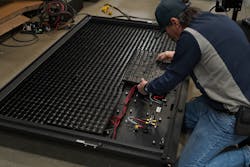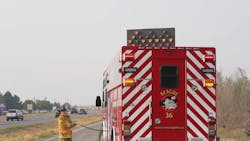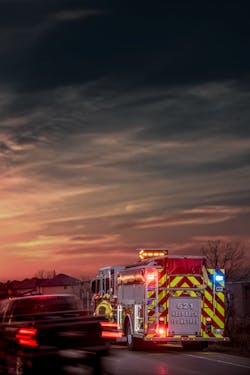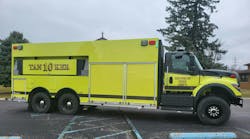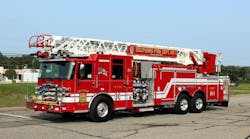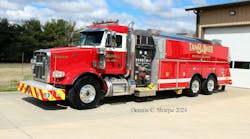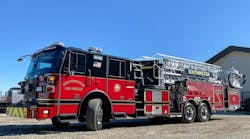One department in Illinois, the Carlock Fire Protection District (CFPD), recently took delivery of a water tender, and after internal discussions, the department decided to equip the new rig and an existing pumper with traffic advisors, noting that the roadways are getting more dangerous—and a struck-by tragedy hit close to home for Carlock firefighters.>
Chief Greg Mohr recalled the 2013 death of Hudson, IL, Fire Protection District Firefighter Chris Brown. Also a career firefighter with the Bloomington, IL, Fire Department, Brown and five other firefighters were struck, along with three emergency vehicles, when a semitrailer drove right into an accident scene hours after snow began to fall on Interstate 39 on March 6, 2013. The firefighters were taken to the hospital, but Brown, unfortunately, didn’t survive his injuries.
Brown’s death rattled the departments in the region, and the CFPD reevaluated its response policies.
“We have worked very hard on our roadway safety practices since Chris died,” Mohr says. “It’s not just a story. This really happened. He was on that rig that left [the station] with four and came home with three.”
Mohr says CFPD firefighters were called to assist in the aftermath of the tragic scene, adding “We just don’t want that here.”
The department comprises 26 volunteer firefighters, and they protect eight miles of Interstate 74 that transverses southern Illinois plus a heavily traveled highway in their community, all of which puts firefighters in danger of being struck at a large number of their annual responses. Members also respond to other roadways to assist neighboring communities and with the new tanker for fires.
“It’s a 3,000-gallon tender on a tandem axle that we end up running a lot of car accidents on the interstate, so we want to be able to block,” Mohr tells Firehouse Magazine.
At first, many members were hesitant to use the new vehicle as a blocker, but he explained that, if it stops one crash “it increases our survival rate by 50 percent.”
After investing the time and effort to conduct some research, the CFPD found that Command Light offers the smaller arrow boards that would fit the space on the existing pumper and reached out to the local dealer to begin the conversation.
Mohr says the department responds with the pumper first on accidents—along with the ambulance—so the concept was to get an arrow board on that rig to begin traffic management as soon as that crew arrives on scene.
“In a best-case scenario, we would have that truck on the road right away, but we might be out there with just an engine and the ambulance for a while until we can get somebody back at the station to respond with the tender.”
The tender is equipped with a version of the message board that allows crews to customize the message at each incident scene.
“By bringing that tanker out and putting that message board up, we will actually put a good, hard block on the scene,” Mohr says.
Having the rotational arrow and message boards, Mohr explains, allows members to park the apparatus and then have the firefighters of that crew get involved with patient care, extrication or whatever other needs that they have.
“When we ordered the sign boards, it met all of our needs and met the Manual on Uniform Traffic Control Devices (MUTCD) standards,” Mohr adds.Bringing tech to departments
Roger Weinmeister, who is president of Command Light, says his company is seeing a shift away from the traditional arrow boards to message boards that provide firefighters more ways to push out safety warnings.
“Arrow boards were first available for Department of Transportation vehicles for a long time, but as you put your fire apparatus in blocking mode, the arrow boards were no longer perpendicular to the traffic flow, so it’s lost most of its effectiveness,” Weinmeister tells Firehouse.
To overcome those challenges, Command Light created rotational advisors that can move 45 degrees in either direction.
Weinmeister says that traffic advisory boards for fire apparatus are specified based on type of apparatus and the space available. In the past, specialty vehicles, such as a rescue or tanker, which have space for the larger traffic boards, were the vehicles of choice. As upgrades were made, the smaller signs grew more popular, to give every fire apparatus a chance to deploy the lifesaving messages.
Command Light offers two models: Vertical, or pop-up, boards are mounted on the cab roof or the top of a heavy rescue and can be recessed into the vehicle; fold-down models can be mounted where space is available on the apparatus.
Weinmeister explains that a DOT truck differs from fire apparatus in that it doesn’t need to work within the space constraints of being parked in a fire station and that it has its entire rear portion available for an arrow/message board, “unlike a pumper, where you have a hosebed or other items you need to pull off the rear.”
Weinmeister indicates that the higher that the traffic advisors are placed while on scene, the better the visibility of the messages.
“If it’s on the back of a pumper and you’re trying to get the attention 200, 300 or 400 feet down the road, the board that’s mounted low on the back of the rig doesn’t have much of that [capability].”
Message boards gain interest
Weinmeister says that his company is seeing a shift in demand from fire departments to message boards from directional boards, adding “If you want to create a message, it’s quite easy to do it. There is a keyboard in the cab, and it’s that simple.”
The message boards, which can display two lines of text, also can display directional arrows, which gives departments more flexibility and options. This functionality also allows better messaging and communications when crews are out on long-duration incidents. Furthermore, the boards follow the guidelines that are set by the MUTCD for size and flash rates, to ensure that drivers can see the message without being distracted.
Weinmeister says that directional arrows are the most visible at the long distances—“You can easily see and understand an arrow at 1,000 feet”—but departments must consider road size, posted speed limits and other factors of the road.
Weinmeister suggests that departments use shorter words at higher flash rates for comprehension and visibility.
Command Light works with all major apparatus manufacturers, and Weinmeister recommends that departments have their dealers contact the company with which they want to work to see what models are the best fit for their apparatus.
Both the arrow boards and the message boards allow for illumination levels to be changed based on the time that they are being used, for the best visibility by motorists. It’s all controlled from inside of the cab with intuitive switches.Retrofitting apparatus
Command Light’s traffic advisors can be retrofitted onto almost any fire apparatus, Weinmeister says.
He suggests that departments connect with Command Light, and the company will work with manufacturers or dealers to install the system, which only requires space where the board will be mounted, a cable to be run to the cab and the installation of a keyboard in the cab.
Mohr says the process to get his department’s rig retrofitted (the installation will be complete around the publication time of this article) has been easy, and the cost that the department will invest is more than worthwhile in consideration of the safety of firefighters and others.
“We have already had other departments reach out and let us know that they will be calling us for accident scenes, because they want the traffic advisors to be deployed for their safety,” Mohr tells us.
The message is clear
“A lot of departments have gotten to the point at roadway incidents that they will watch the traffic patterns as they arrive and have the message on the board before they get out of the rig,” Weinmeister says. “They do that for their own safety and that of the others on the road.”

